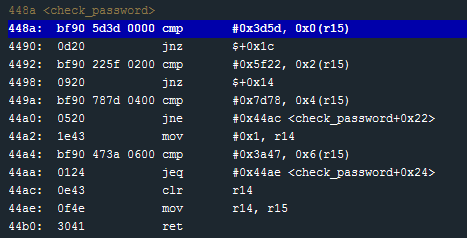Micro Corruption - 02 - Sydney
by
The pop-up documentation for this new lock in Sydney - specifies that the firmware has been revised and will no longer contain the password in memory.
For a walk through of the previous revision of this lock, click here
I start by scrolling through the disassembler to review the main function and see the basic flow of the program.
Starting at offset 0x443c see a mov instruction followed by a call to puts() - prompting the user to enter a password. I then see a get_password() function which will read the users input. Next, the check_password() function will be called.
I’ll take a closer look at check_password to see how it has changed.
In the check_password function I see a series of cmp operations.
448a: cmp #0x3d5d, 0x0(r15)
...
4492: cmp #0x5f22, 0x2(r15)
...
449a: cmp #0x7d78, 0x4(r15)
...
44a4: cmp #0x3a47, 0x6(r15)
After each cmp there is a jnz (jump not zero) to exit the function and set the return value to 0 if the compare failed.
4490: jnz $+0x1c # If not equal, jump 0x1c (28) bytes forward to 44ac
44ac: clr r14 # set r14 to zero
44ae: mov r14, r15 # set r15 as the return value
44b0: ret # return to main
If I look closer at the cmp operations, it looks like each 2 byte literal value is compared with the bytes found at some offset of the address stored in r15. 0x0(r15) - the two bytes at the start of r15 0x2(r15) – the two bytes starting at offset 0x2 of r15 0x4(r15) – the two bytes starting at offset 0x4 of r15
If I string the two-byte literal values from the instructions together I get:
3D5D5F227D783A47
I could convert these bytes to ASCII characters, but since the micro corruption input dialog will accept hex values I can enter this string of bytes directly to test.
I enter the ‘continue’ command in the debugger console to start program execution. When execution reaches the get_password function, I am prompted for input:
Testing the hex string:
Since the debugger automatically breaks/pauses after user-input, I must enter ‘continue’ in the console again. Program execution completes but I do not get a “solved” notification. Interesting…
I will run through again, this time with a breakpoint at the beginning of the check_password function 0x448a.
After setting the break point, I enter ‘reset’ in the Debugger Console and allow program execution until the break point is reached.
With the debugger paused at offset 0x448a, I check the Live Memory Dump – specifically at the address stored in r15 – 0x439c.
The byte sequence found at 0x439c is our input from the password prompt - unchanged. Stepping through the function (‘step’ on the console) shows that the very first cmp operation fails. Why?
The answer: endianness. It turns out the MSP430 micro-controller this lock runs on uses little endian architecture. This means the byte at address 0x439c ( 0x0(r15) ) is the least significant byte and the next byte over at 0x439d ( 0x1(r15) ) is the most significant byte.
In other words, bytes 0x3da in the Live Memory Dump will be read as 0x5d3d in the cmp operation. With this in mind, I will re-work the bytes I collected earlier to account for the little endian architecture.
Original: 3D5D5F227D783A47
Little-Endian: 5D3D225F787D473A
I will reset the lock and run through the prompts again.
This time, with the new byte sequence, I get the satisfying problem-solved notification.







